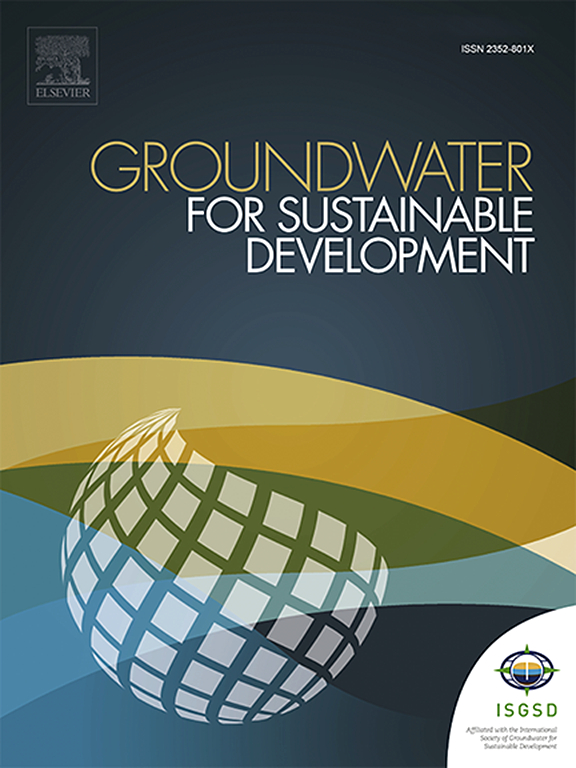Radon concentration in water sources and its associated cancer risks to the populace of Ede, South Western Nigeria
IF 4.9
Q2 ENGINEERING, ENVIRONMENTAL
引用次数: 0
Abstract
An estimated two billion people do not have access to portable and clean drinking water due to diverse pollutants present in water, including Radon (222Rn). For this reason, the World Health Organisation (WHO) designated clean water and sanitation as goal 6 in its 2030 sustainable development (SDG) agenda. This work aimed to measure the concentrations of radon in various water sources at Redeemer’s University campus, Ede, and its environment, and to estimate the associated radiological health hazard. Thirty five (35) boreholes, surface water and hand-dug well water were sampled and analysed for (222Rn) content, and its health risk estimated using the annual effective dose (AED) and the excess lifetime cancer risk (ELCR). (222Rn) distributions in borehole water samples, ranged from 0.51 ± 0.40 to 36.25 ± 2.80 Bq. For the hand-dug well, it ranged from 1.75 ± 1.00 to 5.91 ± 0.20 Bq, and for the stream water, it was 0.106 ± 0.1 Bql−1. The mean radon concentration in surface water, borehole water, and hand-dug well sources were 0.106 ± 0.1 Bq, 15.35 ± 9.73 Bq and 4.25 ± 1.72 Bq, respectively. The measured values in all the water samples was distributed between 0.106 Bq and 36.250 Bq, the average value was 13.330 Bq. The mean AED from inhalation and ingestion of (222Rn) gas was 39.259 Svy−1. Total AED received from all water sources was estimated to be less than 100 Svy−1, which is the WHO and European Union (EU) Commission recommended value. The estimated ELCR showed probabilities of 1 ± 1, 30 ± 12 and 108 ± 70 cases per a million people developing cancer from exposure to radon from surface water, hand-dug wells, and borehole water sources, respectively, which were within the United States Environmental Protection Agency (USEPA) reference limit. This implies that, at present the entire community is safe from any radiologically linked health effects that could arise from exposure to radon gas from water sources.

尼日利亚西南部埃德市水源中的氡浓度及其对民众的相关癌症风险
由于水中存在包括氡(222Rn)在内的各种污染物,估计有20亿人无法获得便携式清洁饮用水。因此,世界卫生组织(WHO)在其2030年可持续发展议程(SDG)中将清洁水和卫生设施指定为目标# 6。这项工作旨在测量埃德市Redeemer大学校园内各种水源及其环境中的氡浓度,并估计相关的放射性健康危害。对35个钻孔、地表水和手挖井水进行了(222Rn)含量分析,并利用年有效剂量(AED)和过量终身癌症风险(ELCR)估算了其健康风险。(222Rn)在钻孔水样中的分布范围为0.51±0.40 ~ 36.25±2.80 Bql−1。手挖井为1.75±1.00 ~ 5.91±0.20 Bql−1,溪水为0.106±0.1 Bql−1。地表水、钻孔水和手挖井源平均氡浓度分别为0.106±0.1 Bql−1、15.35±9.73 Bql−1和4.25±1.72 Bql−1。所有水样的测量值分布在0.106 ~ 36.250 Bql−1之间,平均值为13.330 Bql−1。吸入和摄入(222Rn)气体的平均AED为39.259 μSvy−1。从所有水源接收的AED总量估计小于100 μSvy−1,这是世界卫生组织和欧盟委员会的推荐值。估计的ELCR分别为每百万人暴露于地表水、手挖井和钻孔水源中的氡发生癌症的概率为1±1、30±12和108±70例,均在美国环境保护署(USEPA)的参考限值之内。这意味着,目前整个社区都是安全的,不会因接触来自水源的氡气而产生任何与放射有关的健康影响。
本文章由计算机程序翻译,如有差异,请以英文原文为准。
求助全文
约1分钟内获得全文
求助全文
来源期刊

Groundwater for Sustainable Development
Social Sciences-Geography, Planning and Development
CiteScore
11.50
自引率
10.20%
发文量
152
期刊介绍:
Groundwater for Sustainable Development is directed to different stakeholders and professionals, including government and non-governmental organizations, international funding agencies, universities, public water institutions, public health and other public/private sector professionals, and other relevant institutions. It is aimed at professionals, academics and students in the fields of disciplines such as: groundwater and its connection to surface hydrology and environment, soil sciences, engineering, ecology, microbiology, atmospheric sciences, analytical chemistry, hydro-engineering, water technology, environmental ethics, economics, public health, policy, as well as social sciences, legal disciplines, or any other area connected with water issues. The objectives of this journal are to facilitate: • The improvement of effective and sustainable management of water resources across the globe. • The improvement of human access to groundwater resources in adequate quantity and good quality. • The meeting of the increasing demand for drinking and irrigation water needed for food security to contribute to a social and economically sound human development. • The creation of a global inter- and multidisciplinary platform and forum to improve our understanding of groundwater resources and to advocate their effective and sustainable management and protection against contamination. • Interdisciplinary information exchange and to stimulate scientific research in the fields of groundwater related sciences and social and health sciences required to achieve the United Nations Millennium Development Goals for sustainable development.
 求助内容:
求助内容: 应助结果提醒方式:
应助结果提醒方式:


